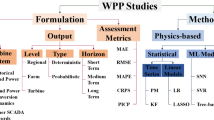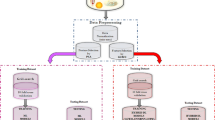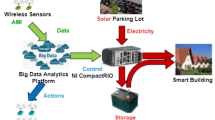Abstract
Multi-regional power grid with interconnected tie-lines has become an increasingly important structure for current power systems, and can efficiently reallocate power resources on a large scale. The power dispatch of a multi-regional power grid involving multiple resources plays a key role in maintaining system balance and improving operating profit. Current optimisation methods for this dispatch problem need to execute a complete optimisation calculation at each dispatch moment, and lack online decision and optimisation abilities. Therefore, we introduce a deep neural network-based hierarchical learning optimisation method to establish an online approach to focused coordination dispatch problems. The method can realise system optimisation based solely on historical operating data. First, the focused coordination dispatch problem is formulated mathematically. Then, we establish a hierarchical structure suitable for online learning methods. Under this designed structure, we establish a learning optimisation model for each agent, and introduce a deep reinforcement learning algorithm for solving the optimisation problems online. Simulation results based on the IEEE 300-bus system are presented to validate the efficiency and availability of the proposed hierarchical method.











Similar content being viewed by others
Abbreviations
- \(N_{n}^{il} ,N_{n}^{{{\text{th}}}} ,N_{n}^{w}\) :
-
The number of flexible load, thermal unit and wind unit in region n
- \(P_{n}^{l} ,\overline{P}_{n}^{l}\) :
-
Forecast and actual load of region n
- \(P_{n,i}^{il} ,\mathcal{P}_{n,i}^{il}\) :
-
The actual value and level of the dispatch amount of flexible load i in region n
- \(P_{n,i}^{tl} ,\mathcal{P}_{n,i}^{tl}\) :
-
The actual value and level of the scheduled power of tie-line from region i to region n
- \(P_{n,i}^{{{\text{th}}}} ,\;\overline{P}_{n,i}^{{{\text{th}}}}\) :
-
The scheduled and actual output of thermal unit i in region n
- \(\mathcal{P}_{n,i}^{{{\text{th}}}} ,\;\overline{\mathcal{P}}_{n,i}^{{{\text{th}}}}\) :
-
The discretised levels of \(P_{i}^{{n,{\text{th}}}} ,\;\overline{P}_{i}^{{n,{\text{th}}}}\)
- \(U_{n,i}^{th}\) :
-
The on/off state of thermal unit i in region n
- \(P_{n,i}^{{{\text{th}},{\text{down}}}} ,P_{n,i}^{{\text{th,up}}}\) :
-
The minimum and maximum output of thermal unit i in region n
- \(P_{n,i}^{{{\text{th}},rd}} ,P_{n,i}^{{{\text{th}},ru}}\) :
-
The minimum and maximum power ramp of thermal unit i in region n
- \(P_{{i,{\text{down}}}}^{tl} ,P_{{i,{\text{up}}}}^{tl}\) :
-
The minimum and maximum power of tie-line i
- \(P_{i,rd}^{tl} ,P_{i,ru}^{tl}\) :
-
The minimum and maximum power ramp of tie-line i
- \(G_{n,j}^{{{\text{th}}}}\) :
-
The thermal units set of group j in region n
- \(P_{n,G}^{w} ,\;\mathcal{P}_{n,G}^{w}\) :
-
The value and level of the scheduled output sum of wind units in region n
- \(\overline{P}_{{n,{\text{sum}}}}^{l} , \overline{P}_{{n,{\text{sum}}}}^{w}\) :
-
The actual load demand and actual output sum of wind units in region n
- \(\overline{\mathcal{P}}_{{n,{\text{sum}}}}^{l} ,\overline{\mathcal{P}}_{{n,{\text{sum}}}}^{w}\) :
-
The discretised level of \(\overline{P}_{{{\text{sum}}}}^{n,l} ,\;\overline{P}_{{{\text{sum}}}}^{n,w}\)
- \(\theta_{{n,{\text{eco}}}} ,\theta_{{n,{\text{cle}}}}\) :
-
The weight for the economy and accommodation of wind power
- \(P_{{n,{\text{sum}}}}^{{{\text{th}}}} ,\mathcal{P}_{{n,{\text{sum}}}}^{{{\text{th}}}}\) :
-
The actual value and level of the output sum of thermal units in region n
References
Looney B (2020) Statistical Review of world energy. British Petroleum (BP), Available from, http://www.bp.com/statisticalreview
Deng X, Lv T (2019) Power system planning with increasing variable renewable energy: a review of optimization models. J Clean Prod 246:231–243
Zeng FD, Bie ZH, Han ZF, et al. (2017) Long-term wind accommodation of interconnected power grids via HVDC tie-line based on aggregate unit model. In: The 3rd IEEE conference on energy internet and energy system integration, Beijing, China, Nov. 26–28
Ye M, Wang H (2019) A robust adaptive chattering-free sliding mode control strategy for automotive electronic throttle system via genetic algorithm. IEEE Access 8(99):68–80
Kamboj VK, Bath SK, Dhillon JS (2016) Multiobjective multiarea unit commitment using hybrid differential evolution algorithm considering import/export and tie-line constraints. Neural Comput Appl 28(11):3521–3536
Basu M (2015) Artificial bee colony optimization for multi-area economic dispatch. Int J Electr Power Energy Syst 49:181–187
Ma S, Zhang H (2018) A novel model of HVDC tie-line scheduling for interconnected grids considering reactive power adjustment cost. In: The international conference of power system technology, Guangzhou, China, Nov. 6-8
Xu F, Ding Q, Han HW et al (2017) Power optimization model and analysis of HVDC Tie-line for promoting integration of inter-regional regional renewable energy accommodation. Autom Electr Syst 41(18):152–158
Conejo AJ, Aguado JA (1998) Multi-area coordinated decentralized DC optimal power flow. IEEE Trans Power Systems 13(4):1272–1278
Tan ZF, Zhong HW, Wang JX et al (2019) Enforcing intra-regional constraints in tie-line scheduling: a projection-based framework. IEEE Trans Power Syst 34(6):4751–4761
Lv K, Tang H, Wang K et al (2019) Coordination dispatch of grid-source-load for the inter-regional power grid under the uncertainties of both source and load sides. Autom Electric Power Syst 43(22):38–45
Ahmadi-Khatir A, Conejo AJ, Cherkaoui R (2014) Multi-Area unit scheduling and reserve allocation under wind power uncertainty. IEEE Trans Power Syst 29(4):1701–1710
Madadi S, Mohammadi-Ivatloo B, Tohidi S (2019) Decentralized optimal multi-area generation scheduling considering renewable resources mix and dynamic tie line rating. J Clean Prod 23(20):883–896
Li ZG, Wu WC, Shahidehpour M (2016) Adaptive robust tie-Line scheduling considering wind power uncertainty for interconnected power systems. IEEE Trans Power Syst 31(4):2701–2713
Wen J, Xu Y (2018) Decentralized coordinated scheduling model of interconnected power systems considering wind power uncertainty. Autom Electr Power Syst 42(16):41–47
Dubey HM, Pandit M, Tyagi N, et al (2016) Wind integrated multi area economic dispatch using backtracking search algorithm. In: The 6th international conference power system, New Delhi, India, Mar. 4–6
Zhou M, Wang M, Li J (2017) Multi-area generation-reserve joint dispatch approach considering wind power cross-regional accommodation. CSEE J Power Energy Syst 3(1):74–83
Babahajiani P, Shafiee Q, Bevrani H (2018) Intelligent demand response contribution in frequency control of multi-area power systems. IEEE Trans Smart Grid 9(2):1282–1291
Pinheiro V, Francato AL, Powell WB (2020) Reinforcement learning for electricity dispatch in grids with high intermittent generation and energy storage systems: a case study for the Brazilian grid. Int J Energy Res 44(3):8635–8653
Chen CY, Cui M, Li FF (2020) Model-free emergency frequency control based on reinforcement learning. IEEE transactions on industrial informatics, Available from, https://ieeexplore.ieee.org/document/8701651
Zhang J, Wang H, Ma M et al (2020) Active front steering-based electronic stability control for steer-by-wire Vehicles via terminal sliding mode and extreme learning machine. IEEE Trans Veh Technol. https://doi.org/10.1109/TVT.2020.3036400
Guan J, Tang H, Wang K et al (2020) A parallel multi-scenario learning method for near-real-time power dispatch optimization. Energy 202:117708
Liu YK, Zhang DX, Gooi H (2020) Optimization strategy based on deep reinforcement learning for home energy management. CSEE J Power Energy Syst 6(3):572–582
Machado J, Carvalho P, Ferreira M (2018) Building stochastic non-stationary daily load/generation profiles for distribution planning studies. IEEE Tran Power Syst 33(1):911–920
Albadi M, El-Saadany E (2011) Comparative study on impacts of wind profiles on thermal units scheduling costs. IET Renew Power Gener 5(1):26–35
Shukla A, Singh S (2016) Clustering based unit commitment with wind power uncertainty. Energy Convers Manag 111(1):89–102
Altameem T, Amoon M, Altameem A (2020) A deep reinforcement learning process based on robotic training to assist mental health patients. Neural Comput Appl. https://doi.org/10.1007/s00521-020-04855-1
Mnih V et al (2015) Human-level control through deep Reinforcement learning. Nature 518:529–833
Mnih V, et al (2016) Asynchronous methods for deep reinforcement learning. In: International conference of machine learning, New York, USA, Jun.19–24
Xie L, Chen Y, Lia H (2012) Distributed online monitoring of quasi-static voltage collapse in multi-area power systems. IEEE Trans Power Syst 27(4):2271–2279
Acknowledgements
The research is supported by State Grid Corporation of China Project “Intelligent Scheduling Technology based on Deep Learning in Flexible Environment” (SGTYHT/19-JS-215).
Author information
Authors and Affiliations
Corresponding author
Ethics declarations
Conflict of interest
The authors declare that there is not conflict of interest.
Additional information
Publisher's Note
Springer Nature remains neutral with regard to jurisdictional claims in published maps and institutional affiliations.
Rights and permissions
About this article
Cite this article
Tang, H., Lv, K., Bak-Jensen, B. et al. Deep neural network-based hierarchical learning method for dispatch control of multi-regional power grid. Neural Comput & Applic 34, 5063–5079 (2022). https://doi.org/10.1007/s00521-021-06008-4
Received:
Accepted:
Published:
Issue Date:
DOI: https://doi.org/10.1007/s00521-021-06008-4




